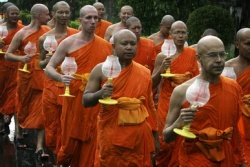Fourth Buddhist council
Fourth Buddhist Council is the name of two separate Buddhist council meetings. The first one was held in the 1st century BC, in Sri Lanka. In this fourth Buddhist council the Theravadin Pali Canon was for the first time committed to writing, on palm leaves. The second one was held by the Sarvastivada school, in Kashmir around the 1st century AD.
Fourth Buddhist Council in Sri Lanka
The 1st Fourth Buddhist Council (Theravada tradition) was held in response to a year in which the harvests in Sri Lanka were particularly poor, and many monks subsequently died of starvation. Because the Pali Canon was in that time solely remembered by heart, the surviving monks recognized the danger of not writing the teachings of the Tipitaka down, so that even if some of the monks (whose duty it was to study and remember parts of the Tipitaka for later generations) died, the teachings would not be lost. This Fourth Buddhist Council took three years.
The Fourth Buddhist Council was held in Tambapanni (Sri Lanka) under the patronage of King Vattagamani (r. 103-77 BCE). The main reason for its convening was the realization that it was now not possible for the majority of monks to retain the entire Tipitaka in their memories as had been the case formerly for the Venerable Mahinda and those who followed him soon after. Therefore, as the art of writing had, by this time developed substantially it was thought expedient and necessary to have the entire body of the Buddha's teaching written down.
King Vattagamani supported the monk's idea and a council was held specifically to commit the entire Tipitaka to writing, so that the genuine Dhamma might be lastingly preserved. To this purpose, the Venerable Maharakkhita and five hundred monks recited the words of the Buddha and then wrote them down on palm leaves. This remarkable project took place in a cave called, the Aloka lena, situated in the cleft of an ancient landslip near what is now Matale. Thus the aim of the Council was achieved and the preservation in writing of the authentic Dhamma was ensured. In the 18th century, King Vijayarajasiha had images of the Buddha created in this cave.
After the Council, palm leaves books appeared, and were taken to other countries, such as Burma, Thailand, Cambodia and Laos. The Tipitaka and its commentaries were originally brought to Sri Lanka by the missionary monk Mahinda of the Third Buddhist Council.
Fourth Buddhist Council in Kashmir
The 2nd Fourth Buddhist Council (Sarvastivada tradition) is said to have been convened by the Kushan emperor Kanishka (r. 127-151 CE), perhaps in 78 CE at Jalandhar or in Kashmir. The Fourth Council of Kashmir is not recognized as authoritative in Theravada; reports of this council can be found in scriptures which were kept in the Mahayana tradition. The Mahayana tradition based some of its scriptures on (refutations of) the Sarvastivadin Abhidharma texts, which were systematized at this council.
It is said that for the Fourth Council of Kashmir, Kanishka gathered 500 monks headed by Vasumitra, partly, it seems, to compile extensive commentaries on the (Sarvastivadin) Abhidharma, although it is possible that some editorial work was carried out upon the existing canon itself. The main fruit of this Council was the vast commentary known as the Mahā-Vibhāshā ("Great Exegesis"), an extensive compendium and reference work on a portion of the Sarvāstivādin Abhidharma.
Scholars believe that it was also around this time that a significant change was made in the language of the Sarvāstivādin canon, by converting an earlier Prakrit version into Sanskrit. Although this change was probably effected without significant loss of integrity to the canon, this event was of particular significance since Sanskrit was the official holy language of Brahmanism in India, and was also being used by other thinkers (regardless of their specific religious or philosophical allegiance), thus enabling a far wider audience to gain access to Buddhist ideas and practices. For this reason, all major (Sarvastivad and Mahayana) Buddhist scholars in India thereafter wrote their commentaries and treatises in Sanskrit.
